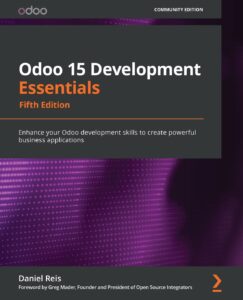Titled as an indispensable tome for both neophytes and veterans in the Odoo development sphere, this book carves a niche for itself by an attempt to address the gaps left by the official Odoo documentation. Where the official channels may lack in terms of completeness and contemporaneity, this guide represents a useful approach to foundational knowledge and advanced technical for developers in the Odoo environment. Despite being focussed on Odoo 15, we find this book to remain very relevant and great entry-level insight for those seeking further technical knowledge on this great ERP.

The book’s layout is intuitively organised. Early chapters are dedicated to equipping users with essential development practices, inclusive of practical examples that bridge the gap between theory and application. Notably, it extends its utility beyond the developer community, offering insights valuable for standard users through topics like data import/export, application structuring, and the broader ecosystem of Odoo applications. We believe much of the book would be of use to Project Leaders and those responsible for leading an ERP implementation within their own organisation.
The book positions itself as one that caters specifically to developers who want to learn Odoo application development, as well as teachers, trainers and Odoo team managers who engage with the platform routinely. It does state that some familiarity with the coding languge Python is needed, but we beleive many of the earlier chapters are relevant for those who want to deep dive on the platform.
To provide context, the book is arranged in the following fashion. The italicised chapters remain relevant even without a coding background:
Table of Contents
- Quick Start Using the Developer Mode
- Preparing the Development Environment
- Your First Odoo Application
- Extending Modules
- Importing, Exporting, and Module Data
- Models – Structuring the Application Data
- Recordsets – Working with Model Data
- Business Logic – Supporting Business Processes
- External API – Integrating with Other Systems
- Backend Views – Designing the User Interface
- Kanban Views and Client-Side QWeb
- Creating Printable PDF Reports with Server-Side QWeb
- Creating Web and Portal Frontend Features
- Understanding Odoo Built-In Models
- Deploying and Maintaining Production Instances
The depth of coverage on developing custom modules, navigating the ORM framework, and designing user interfaces is extremely helpful to manifesting as a holistic guide. It adeptly balances technical detail with accessibility, making it a valuable asset not just for developers, but also for analysts and consultants aiming to grasp the system’s underpinnings.
While the book excels in providing a robust reference for navigating the vast landscape of Odoo, it admittedly could enrich its narrative by outlining compelling reasons for choosing Odoo over alternative solutions. This inclusion could further solidify its position as a comprehensive guide for decision-makers contemplating Odoo’s adoption.
On the development side, we believe that future editions could benefit from a deeper dive into integrating external email servers, expanding on studio features, and elaborating on technical resources that could further empower standard users with automated actions.
We do believe this is a very useful book for budding Odoo developers while also providing great utility for those who routinely engage with the platfrom but want to understand further what is happening behind the scenes. Its a practitioners book with many practical outcomes and examples. For those less adept at coding or computers, then perhaps Odoo’s internal suite of learning videos via the Odoo Academy will be sufficient. For those craving more, this book is worth a try.




